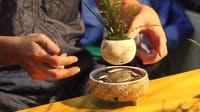Students from Johns Hopkins University build an adjustable prosthetic foot designed to allow female amputees to wear a variety of shoes, from flats to sky high heels.
Prominence is a prosthetic foot that adjusts to fit heels up to four inches high.
Johns Hopkins University engineering students hope their invention will help change lives for women who've lost a leg or foot to amputation.
Katelyn Koons, Johns Hopkins University Mechanical Engineering team member, saying:
"You unlock the lever. You adjust wherever you want your foot to be. We need to have prosthetics that can accommodate any shoe. Women can wear any shoe. They can go into DSW (shoe store) and try on any pairs of shoes and not carry multiple prosthetics in a big handbag."
The idea for Prominence came from women in the military.
The U.S. Department of Defense says 76 American military women have had lower extremity amputations since the war in Afghanistan began in 2000.
But a ladies prosthetic foot is hard to find, says Dr. Jim Gilman, of Johns Hopkins Military and Veterans Health Institute.
"Most of the amputees are male, and based on numbers, commercially most of the work is going to be done based focused on male legs and male feet."
Two patients at Walter Reed National Military Medical Center's amputee clinic, who asked not to be identified, advised the design team.
What they came up with is an ankle that rotates to different heel heights with interlocking aluminum disks.
Engineer Joey Tilson says Prominence's base is rounded to mimic the ball of a human foot.
"A lot of the pressure gets put on the front of the foot. So right now the foot is flat. But as they put pressure on it, it will actually bend the foot into a normal position that they would be using. And that's due to the design of this carbon fiber footplate here."
Amputees tested the prototype, starting from a flat foot up to a 1-inch high heel.
This 4-inch gold stiletto has not yet been tested due to concerns about falling.
Continued research could one day put Prominence within reach for many women, including those who have lost a limb to injury or illness.



